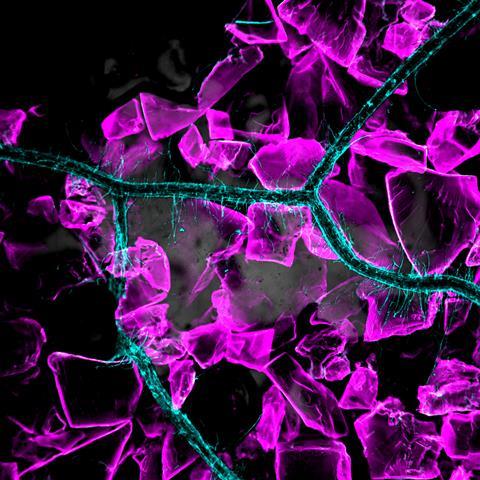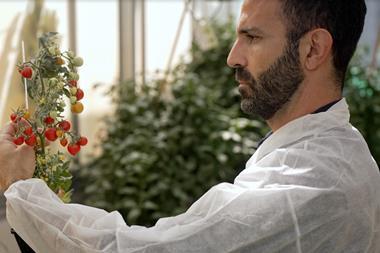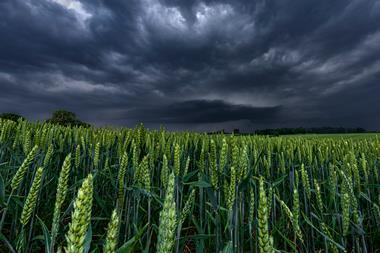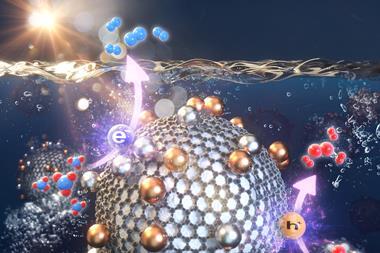The farming industry’s reliance on nitrogen compounds is altering the environment, but Ian Le Guillou finds a better understanding of the interplay between plants and microbes could help to reduce the impact
‘The power of population is so superior to the power of the earth to produce subsistence for man, that premature death must in some shape or other visit the human race.’ So wrote UK economist Thomas Malthus in his influential 1798 essay, setting out his arguments as to why the linear growth in food supply could never keep up with the geometric growth of the human population.
One can imagine that he would be surprised to find obesity as one of the world’s challenges over 200 years later, despite the global population increasing almost 10-fold since his day.
This demand on the food supply has only been possible to meet thanks to the Haber–Bosch process. Commercialised in 1910 by Fritz Haber and Carl Bosch for BASF, this energy-intensive reaction converts nitrogen and hydrogen into ammonia, an essential source of bioavailable nitrogen for plants. It is estimated that current crop production could only sustain half the world’s current population without the synthetic fertilisers produced in this way.
This ability, described by BASF as ‘bread from air’, comes at a severe environmental cost. The production of ammonia fertiliser accounts for approximately 1% of the world’s energy use. And once applied to the field, about half of the nitrogen fertiliser used globally is lost to the environment. To make matters worse, some is lost in the form of nitrous oxide, N2O, a potent greenhouse gas that further compounds the effect on the climate.
How can we tune soil processes in a way that the plant will make the most of the fertiliser?
Nitrogen also leaches into waterways in the form of nitrates. This causes blooms of algae, which starve the water of oxygen and kill fish. There are hundreds of hypoxic ‘dead zones’ in coastal waters, the largest of which is 60,000 km2 in the Baltic sea.
‘The issue of nitrate leakage in the soil is a very big issue at the EU level at the moment, with several countries having major issues,’ says Herve Vanderschuren, a professor in bioscience engineering from KU Leuven in Belgium.
Breeding traits
Fixing these problems is not simple: banning synthetic fertilisers would lead to global food shortages. However, using biological processes already available in nature could improve the efficiency of plants’ use of nitrogen.
It’s a conundrum that exercises Maria Hernandez, a soil scientist at the John Innes Centre in Norwich, UK. ‘How can we tune the soil processes in a way that the plant will make the most of the fertiliser? So that every penny of fertiliser we put in goes into yield, and it doesn’t go into contaminating the environment,’ she says.
Among the root causes of nitrogen loss are microbes in the soil, like the bacterium Nitrosomonas. These chemolithotrophs use enzymes to oxidise ammonium into nitrate, which provides them with energy. To reduce loss, farmers and fertiliser manufacturers try to slow this process and keep the nitrogen in the form of ammonium. The ion’s positive charge helps it to stay in the soil for longer, giving the plants more time to take it up. One way to do this is by adding synthetic nitrification inhibitors to the fertiliser, which are used widely. However, some inhibitors have stopped being used because of environmental toxicity.
‘You don’t want to completely suppress the process because accumulating ammonium is also risky. The plants might not grow as well because the plants require both forms [of nitrogen],’ says Hernandez. ‘The synthetic [inhibitor] has the risk that it might be too strong and also be toxic for other bacteria in the soil that you don’t want to damage.’
When breeding companies are improving wheat, for example, they just provide nitrogen and then they select the best performing
While managing this process manually is a tricky balance, fortunately for us nature has given us a head start. Plants can influence bacterial activity in the soil by secreting substances referred to as exudates. Some plants’ exudates contain biological nitrification inhibitors, or BNIs, which slow down microbes converting ammonium. While there is still a lot to learn about how this process works, the plants appear to produce more BNIs when there are high levels of ammonium present in the soil.
‘Four or five years ago, we started to see that wheat actually does that. That’s very important because it’s a crop,’ says Hernandez. ‘The problem is that it’s only a few varieties that do that at the moment.’ She is now trying to identify genes in old varieties of wheat responsible for nitrification inhibitors that can be bred into commercial varieties. She is cross-breeding Persian wheat with modern wheat and monitoring the effects on the bacteria and available nitrate.
The commercial varieties of wheat developed have been carefully refined to produce the biggest yields for farmers, says Vanderschuren. By contrast, the ability to produce BNIs would not have been paid any attention. ‘Definitely, these are not traits that have been selected over time. When breeding companies are improving wheat, for example, they manage this in a very conventional way. They just provide nitrogen – ammonium nitrates – to the plots and then they select the best performing,’ he says.
If environmental concerns and regulations on the use of nitrogen fertilisers increase, however, new crop varieties may be needed to suit the circumstances. There is precedent for this: when concerns over pesticide and fungicide use grew in the late 1990s, it provided incentives for introducing new disease-resistant traits into crops.
Catch crops
Adding BNI production ability to wheat may reduce fertiliser wastage, but it is still only one crop. An alternative approach to seed fields with BNIs more widely is to use catch crops. Before sowing crops in the spring, farmers will often plant catch crops to enhance the soil over the winter. These catch crops help to prevent soil erosion, but they could play a role in reducing nitrification.
Vanderschuren is working on a project with partners across Europe to identify plants that can produce BNIs and to understand if they could improve soil fertilisation. The idea is that farmers could sow these plants as catch crops to maintain the available nitrogen in the soil and prevent it being lost into waterways or the atmosphere.
‘With a catch crop that is releasing the BNI compounds, the idea is really to create kind of a slow nitrification environment in the soil […] because of this exudate that has been released for the whole winter and the beginning of the spring,’ says Cécile Thonar, a plant scientist from the University of Liège, Belgium, who is collaborating with Vanderschuren.
There’s definitely less effort in terms of breeding and traits in catch crops
Not only could these catch crops help to lock in the nitrogen already in the soil, but they could be turned into an organic fertiliser with naturally occurring nitrification inhibitors. ‘The hypothesis is that these BNI compounds are also produced in the above-ground tissue,’ says Thonar. ‘We want to see whether we can produce a kind of compost from this catch crop and see whether the ammonium content of this organic material can also be preserved or maintained for a longer period with the BNI that is present inside the tissue.’
One of the advantages of this approach is that it can also help organic farming. Nitrogen loss to the environment is also a problem for organic fertilisers, particularly slurry and manure, which are rich in nitrogen. To be certified organic, however, farmers cannot use chemical inhibitors, so would benefit from making the most of the biological mechanisms existing in nature. ‘There is more and more tendency to go towards organic agriculture. There is a strong interest from society, so those problems will just further increase in the future,’ says Vanderschuren.
While cereal crops have been intensively fine-tuned to improve their properties, catch crops receive much less attention. ‘If you think about catch crops, where there’s definitely less effort in terms of breeding and traits, you can imagine that there is a huge potential if you can identify the traits that need to be improved for agriculture,’ says Vanderschuren.
In their search, Vanderschuren and Thonar will examine germplasm collections to find plants that are effective nitrification inhibitors. ‘It could be a weed even, it doesn’t need to be a useful crop,’ says Vanderschuren. ‘We have established bio-assays to measure how effective those exudates are against nitrifiers. We now have all the analytical tools to assess a trait that has been maybe overlooked.’
See-through soils
The plants, however, are just one half of the equation. The bacteria are the hidden partner in all of this. By doing genetic sequencing on the soil samples, Thonar can monitor the size of the population of the nitrifying bacteria and the effect of adding synthetic inhibitors to organic fertilisers. ‘We have seen that in the presence of the inhibitors, the size of the population was really reduced,’ she says.

With the catch crops, the team are planning to investigate the effects of the biological inhibitors on the soil bacteria. While Nitrosomonas is one of the main bacteria studied in nitrification, several species are now known to contribute. ‘There are many other bacteria that we have just recently described that are also involved in nitrogen cycling,’ says Hernandez. ‘But the problem is that we have been very focused on only a few [species]. We are just learning as we go because looking at the soil microbiome is telling us much more – the root exudates are having a great impact.’
Lionel Dupuy, a plant–environment researcher at the Basque Foundation for Science at the Neiker Institute in Spain, is also interested in the behaviour of bacteria. ‘It’s very hard to see a microbe as one type of species doing one thing, another type of species doing another thing – it’s a very complex network of interactions,’ he says. ‘The moment you dig the soil, you lose [all of] these interactions that are happening.’
Dupuy is developing new technologies that will allow soil scientists to study these interactions without the need for a trowel. He is creating plastic particles that can be used as a form of transparent soil that enables the study of fluorescent bacteria without disrupting the delicate structures. ‘The main challenge of making a transparent soil is not transparency. Otherwise, we would just use glass beads. It’s to have material that has a refractive index that is very close to water,’ he says.
In addition, the plastic needs to have similar chemical properties to soil particles, including allowing mineral ions to attach to the surface and being hydrophilic. Teflon has the right refractive index, but it is famously hydrophobic. However, by chemically modifying it to hold water, Dupuy has successfully used it in his transparent soils.
Although described as soil, in consistency it is more like sand, he says: ‘Right now, there’s so little done in soil that we’re happy to work just with the sand. [Agricultural soil] could be done in the future, but that’s a lot of work.’
Flocking like birds
By adding genes for fluorescent proteins into bacteria of interest, Dupuy and his team can follow their movements through the transparent soil. They can build up a three-dimensional reconstruction with a technique called light-sheet microscopy, which uses a laser to produce a thin sheet of light to create the optical equivalent of taking a section slice while leaving the sample undisturbed. ‘We are making stunning observations of the migration of microbes in the soil,’ he says. ‘We see microbes behaving like a flock of birds.’
Dupuy is particularly interested in the bacteria that live around the roots and how they interact with plants and one another. ‘We’re trying to understand what makes microbes stay on the roots if it’s a beneficial [microbe]. Because the soil is highly competitive; there are lots of microbes already out there. So how do you maintain the right type of microbes?’ says Dupuy.
We see microbes behaving like a flock of birds
Although genetic sequencing has made it straightforward to identify which bacteria are present, it is still a big challenge to predict which will survive and remain there over time. ‘There’s something that we fundamentally do not understand about which bacteria stay in the soil and get associated with the crop,’ says Dupuy.
Some microbes are even sold commercially for use by farmers. So-called biofertilisers can contain fungi and bacteria to fix nitrogen, solubilise phosphorus or nitrogen, or improve plant health. But Dupuy says that these biofertilisers are not widely used. ‘One main reason is that it’s a little bit unpredictable. In some cases it’s going to work and in some other cases not going to work. That’s a problem for a farmer; he wants to make sure he’s going to have [improved] yield.’
‘We cannot predict and we cannot understand, so therefore we cannot control. That’s one of the main limitations for having biological fertilisers.’
Data bloom
The global use of nitrogen bears a striking resemblance to the burning of fossil fuels releasing carbon into the atmosphere. These elements are widely available but trapped in a way that limits their ability to alter their surroundings. Unlocking atmospheric nitrogen from its triple bond in enormous amounts leaves it free to make profound changes to the ecosystem.
It’s a very strong argument to say biodiversity is very important
Just as improved energy efficiency led to reductions in fossil fuel use, helping crops to maximise use of nitrogen fertilisers should lessen the environmental impact. Fortunately, the tools already available in nature have given us a head start and now we know where to look.
‘I think it’s a very strong argument to say biodiversity is very important because it might be that in 10 years’ time, we find another very interesting trait in connection to soil and roots that we also need to promote and this might be there in the genetics in the [plant germplasm] collections,’ says Vanderschuren.
The well-ordered and well-studied plant genetics libraries bear stark contrast to our understanding of the microbes in the soil. These two approaches may be complementary, however; developing new plant traits can help to improve nitrogen use efficiency in the near future, while the rapid growth in our microbial knowledge offers hope of the next big advance to avoid the Malthusian trap.
‘The quantity of information that’s coming out is just booming. In a way, we’re not quite sure what to do with it. It’s almost too much,’ says Dupuy. ‘We cannot grasp it yet, but there is a feeling that there is something to be discovered here.’
Ian Le Guillou is a science writer based in Paris, France













No comments yet